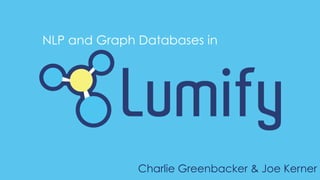Natural Language Processing and Graph Databases in Lumify
- 1. NLP and Graph Databases in Charlie Greenbacker & Joe Kerner
- 2. Agenda Graph Databases Lumify Overview Introductions Natural Language Processing
- 3. photo:&Columbia&Pictures& About me: @greenbacker Theories: popular tripe Methods: sloppy Conclusions: highly questionable
- 4. Best reason for not finishing PhD
- 6. is an open source big data analysis and visualization platform built by Altamira engineers
- 7. Key Lumify Concepts structure for organizing information (i.e., your data model) Ontology any “thing” you want to represent (e.g., person, place, event) Entities a link between two entities (e.g., leader-of, works-for, sibling-of) Relationships data about an entity (e.g., first name, last name, date of birth) Properties collection of entities and the relationships between them Graph
- 8. Live Demo
- 9. Who can Lumify help?
- 10. Lumify helps analysts fuse structured and unstructured data from myriad sources into actionable intelligence. Intelligence Analyst
- 11. Law enforcement personnel can use Lumify to explore criminal networks, uncover hidden connections, and develop leads. Police Investigator
- 12. Lumify analyzes financial data and transaction records to help detect fraud and identify possible insider threats. Financial Analyst photo:&Ken&Teegardin&(h9ps://flic.kr/p/9rn9Yh)&
- 13. Scientists, law firms, news organizations, and others can track their research in Lumify to unearth latent knowledge and discover critical new insights. Research Staff photo:&UK&NaConal&Archives&(h9p://bit.ly/1n9dhR8)&
- 14. Why Lumify?
- 15. •  Distributed under the permissive Apache 2.0 license •  No restrictions on modifications •  No licensing or usage constraints Free and Open Source
- 16. Built on Scalable Open Source Tech Hadoop&CDH&4& Accumulo& ElasCcSearch& tesseract&CLAVIN& CMU&Sphinx&OpenNLP& OpenCV& ffmpeg& Apache&Storm& Secure&Graph& custom&code&
- 17. •  Separate security restrictions at the entity, property, and relationship level •  Implemented in and enforced by Accumulo cell-level security Highly Secure Joaquin Guzman Loera DOB: 1957-04-04 POB: Badiraguarto Nationality: Mexican Founded: 2010-01-11 Location: Mexico City Employees: 121 Zarka de Mexico
- 18. •  Full-time development staff •  Custom development and customization services •  Commercial support offerings Supported
- 19. •  Day-to-day development done on Amazon infrastructure •  Primarily use EC2, VPC, S3, SES, CloudWatch •  Altamira is an AWS consulting partner AWS Compatible
- 20. Natural Language Processing in
- 21. Text Extraction video text docs structured data images OCR tesseract audio CMU Sphinx CMU Sphinx OCR tesseract extractor
- 22. Text Enrichment •  Apache OpenNLP •  Named Entity Recognition •  Extracts names of entities from unstructured text •  Persons, Orgs, & Locations •  Highlighted in preview text •  User must confirm/resolve •  CLAVIN •  Geospatial Entity Resolution •  Resolves extracted location names to gazetteer records •  Solves “Springfield problem” •  Disambiguates place names •  Turns text docs into maps!
- 23. Machine-powered entity extraction and resolution, combined with human QA and supplementation, supports rich semantic analysis of raw text. Enriched Text Documents Drug Lord “El Chapo” Captured in Mexico PUBLISHED DATE SOURCE Audit 2014/02/22 Wikipedia Add Property Although Guzman had long hidden successfully in remote areas of the Sierra Madre mountains, the arrested members of his security team told the military he had begun venturing out to Culiacan and the beach town of Mazatlan. A week prior to his capture, Guzman and Zambada were reported to have attended a family reunion in Sinaloa. The Mexican military followed the bodyguards tips to Guzman’s ex-wife’s house, but they had trouble ramming the steel-reinforced front door, which allowed Guzman to escape through a system of secret tunnels that connected six houses, eventually moving south to Mazatlan. He planned to stay a few days in Mazatlan to see his twin baby daughters before retreating to the mountains. On 22 February 2014, at around 6:40 a.m., Mexican authorities arrested Guzman at a hotel in a beach front area in Mazatlan, Sinaloa, following an operation by the Mexican Navy, with joint intelligence from the DEA and
- 24. Benefits to Users quickly find relevant data without reading Increases Discoverability machines process text faster than humans Helps Deal with Information Overload enables object-based analysis & investigations Uncovers Hidden Connections
- 25. Future NLP Integration e.g., Stanford NER, SUTime, MITIE Support other NER tools e.g., OpenIE (formerly ReVerb) Event/Relationship Extraction augmenting/extending GATE/ANNIE Coreference Resolution e.g., frequency analysis, topic modeling, sentiment analysis Additional Text Analytics use non-English language models for NER, etc. Multilingual Support
- 26. Graph Databases in view part 2 of the presentation here: github.com/altamiracorp/secure-graph-presentation



























